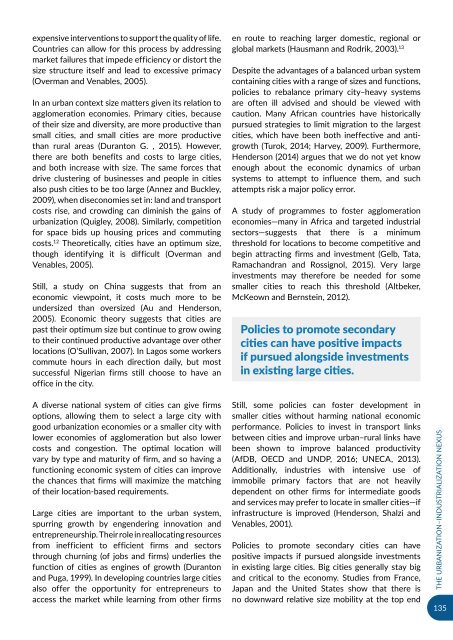URBANIZATION AND INDUSTRIALIZATION
Economic%20Report%20on%20Africa%202017%20UNECA
Economic%20Report%20on%20Africa%202017%20UNECA
You also want an ePaper? Increase the reach of your titles
YUMPU automatically turns print PDFs into web optimized ePapers that Google loves.
expensive interventions to support the quality of life.<br />
Countries can allow for this process by addressing<br />
market failures that impede efficiency or distort the<br />
size structure itself and lead to excessive primacy<br />
(Overman and Venables, 2005).<br />
In an urban context size matters given its relation to<br />
agglomeration economies. Primary cities, because<br />
of their size and diversity, are more productive than<br />
small cities, and small cities are more productive<br />
than rural areas (Duranton G. , 2015). However,<br />
there are both benefits and costs to large cities,<br />
and both increase with size. The same forces that<br />
drive clustering of businesses and people in cities<br />
also push cities to be too large (Annez and Buckley,<br />
2009), when diseconomies set in: land and transport<br />
costs rise, and crowding can diminish the gains of<br />
urbanization (Quigley, 2008). Similarly, competition<br />
for space bids up housing prices and commuting<br />
costs. 12 Theoretically, cities have an optimum size,<br />
though identifying it is difficult (Overman and<br />
Venables, 2005).<br />
Still, a study on China suggests that from an<br />
economic viewpoint, it costs much more to be<br />
undersized than oversized (Au and Henderson,<br />
2005). Economic theory suggests that cities are<br />
past their optimum size but continue to grow owing<br />
to their continued productive advantage over other<br />
locations (O’Sullivan, 2007). In Lagos some workers<br />
commute hours in each direction daily, but most<br />
successful Nigerian firms still choose to have an<br />
office in the city.<br />
A diverse national system of cities can give firms<br />
options, allowing them to select a large city with<br />
good urbanization economies or a smaller city with<br />
lower economies of agglomeration but also lower<br />
costs and congestion. The optimal location will<br />
vary by type and maturity of firm, and so having a<br />
functioning economic system of cities can improve<br />
the chances that firms will maximize the matching<br />
of their location-based requirements.<br />
Large cities are important to the urban system,<br />
spurring growth by engendering innovation and<br />
entrepreneurship. Their role in reallocating resources<br />
from inefficient to efficient firms and sectors<br />
through churning (of jobs and firms) underlies the<br />
function of cities as engines of growth (Duranton<br />
and Puga, 1999). In developing countries large cities<br />
also offer the opportunity for entrepreneurs to<br />
access the market while learning from other firms<br />
en route to reaching larger domestic, regional or<br />
global markets (Hausmann and Rodrik, 2003). 13<br />
Despite the advantages of a balanced urban system<br />
containing cities with a range of sizes and functions,<br />
policies to rebalance primary city–heavy systems<br />
are often ill advised and should be viewed with<br />
caution. Many African countries have historically<br />
pursued strategies to limit migration to the largest<br />
cities, which have been both ineffective and antigrowth<br />
(Turok, 2014; Harvey, 2009). Furthermore,<br />
Henderson (2014) argues that we do not yet know<br />
enough about the economic dynamics of urban<br />
systems to attempt to influence them, and such<br />
attempts risk a major policy error.<br />
A study of programmes to foster agglomeration<br />
economies—many in Africa and targeted industrial<br />
sectors—suggests that there is a minimum<br />
threshold for locations to become competitive and<br />
begin attracting firms and investment (Gelb, Tata,<br />
Ramachandran and Rossignol, 2015). Very large<br />
investments may therefore be needed for some<br />
smaller cities to reach this threshold (Altbeker,<br />
McKeown and Bernstein, 2012).<br />
Policies to promote secondary<br />
cities can have positive impacts<br />
if pursued alongside investments<br />
in existing large cities.<br />
Still, some policies can foster development in<br />
smaller cities without harming national economic<br />
performance. Policies to invest in transport links<br />
between cities and improve urban–rural links have<br />
been shown to improve balanced productivity<br />
(AfDB, OECD and UNDP, 2016; UNECA, 2013).<br />
Additionally, industries with intensive use of<br />
immobile primary factors that are not heavily<br />
dependent on other firms for intermediate goods<br />
and services may prefer to locate in smaller cities—if<br />
infrastructure is improved (Henderson, Shalzi and<br />
Venables, 2001).<br />
Policies to promote secondary cities can have<br />
positive impacts if pursued alongside investments<br />
in existing large cities. Big cities generally stay big<br />
and critical to the economy. Studies from France,<br />
Japan and the United States show that there is<br />
no downward relative size mobility at the top end<br />
THE <strong>URBANIZATION</strong>–<strong>INDUSTRIALIZATION</strong> NEXUS<br />
135


